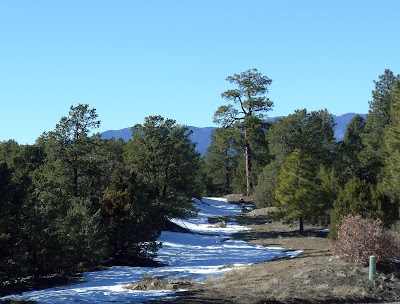As long as we have three wheels on the ground, we’re fine, she insisted.
 |
| Below the Ridge, by Carol L. Douglas. |
If you’ve worked with me in the last few years, you know that I can no longer stand to paint. My back has given me fits since I had radiation twenty years ago. I’ve seen three different surgeons since then. The consensus was that I wasn’t a good candidate for spinal surgery.
Last summer, a fellow painter gave me a prescription pain patch for my lower back. With that, codeine, and a brace I stood long enough to do a (bad) Quick Draw. I could barely sit to drive home to Maine.
Doctors are thin on the ground where we live, so we see a nurse practitioner. He suggested I try physical therapy for my back. I’ve been at it for a bit more than a month now, twice a week when I’m home. I try very hard to do my assigned exercises no matter where I am.
 |
| Snow sublimates rapidly at this altitude, even in sub-freezing temperatures. |
After Jimmy the Donkey came to help me paint on Tuesday, I decided I’d best try to stand for a while. I trust him, but he shares his pasture with two horses. It felt great—better by far than sitting. I’ve now stood to paint for the past three days. It hasn’t been perfect, but if I have a nearby fence or branch to stabilize myself with, I’m fine. Miracles come in many forms, and one of them is my physical therapist.
The snow here is lighter and finer than what’s back east, and the sun so intense that it rapidly burns off of south-facing exposures.
Jane Chapin and I drove to a nearby hamlet to paint log barns in the snow. It was in the teens and low twenties when we started, with a stiff wind. Even as we shivered, the local dogs basked comfortably at our feet.
 |
| The beautiful dogs that kept me company while I painted. Don’t they look like lions in the dry grass? |
I doubt these dogs have a breed name; I’ve heard them called ‘Mexican dogs’. They’re often brindle- or golden-coated, with strong terrier bodies and lots of smarts. These two kept me company during
Santa Fe Plein Air Fiesta, and they were back again as if no time at all had passed. They’re such fine animals that if the opportunity to buy a puppy presented itself, I’d seriously consider it.
There are roads here that are no more than lanes. Slipping down one with difficulty, our canine pals trotting at our side, we came to a point where we couldn’t see over the drop. It was time to back our way out. Piñon and white pine branches that had moved grudgingly when we were heading forward, steadfastly refused to budge as we backed out. “That’ll buff out,” Jane said optimistically. I hope so; it’s her truck.
 |
| By the time we were done painting, my hands were so cold I could no longer even draw accurately. |
We tried the high road. “I think there’s a turnaround right past the overlook,” Jane said. Possibly, but the road was drifted in. There was a thousand-foot drop to our left. Still, Jane managed to do a 37-point turn to get us out of there. “As long as we have three wheels on the ground, we’re fine,” she said as I gingerly opened one eye.
Jane is very petite, and that truck is very large, but she handled it like a pro. She’d be a great one to paint in the Arctic with, but at that point, a warm lunch by the stove sounded like a more prudent plan.








